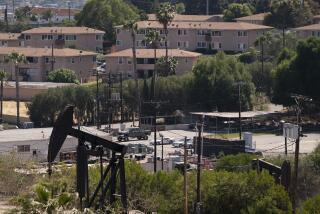Black Gold
- Share via
Sexy it’s not. Drilling for oil is a hard, dirty, dangerous and low-profile endeavor, and the mundane names of drilling companies seldom make headlines.
Yet their stockholders couldn’t be happier.
The oil-drilling sector has been the stock market’s biggest gusher in 1996, thanks to rising prices for crude oil and--pardon the economic jargon--a tight supply-and-demand trend that’s swelling the companies’ profits.
Of the 96 market sectors tracked by the Dow Jones Global Industry index, its group of oil-drilling stocks is ranked No. 1 for its nearly 90% surge in price for the year so far.
The group’s shares include those of leading players Global Marine Inc., Nabors Industries Inc., Parker Drilling Co. and Rowan Cos. Setting the pace has been Global Marine: Its stock trades at about $19 a share, having skyrocketed from $7.75 in January and a paltry $1 in 1992.
Naturally, though, investors now wonder whether the rally in oil-drilling stocks is nearly tapped out.
Probably not, some analysts contend. Profits for most of the drillers--especially those involved in offshore drilling--should continue to grow nicely, with the stocks advancing in step, they say.
*
To understand why, a bit of background is needed:
The supply of mobile offshore drilling rigs peaked at about 700 in the mid-1980s when the oil boom collapsed. As oil prices fell, so did the daily rates to rent those rigs, to the point where manufacturers virtually stopped building new ones. Since then, age and use have reduced the rig fleet even further, to about 550 today, according to the Value Line Investment Survey, a market research firm.
Fast-forward to this year. Crude oil prices have shot up: The spot, or current, market price of Arab light crude, for instance, has jumped from $15 a barrel in February to about $23.50 now. As prices rose, exploration picked up and that led to more use of the rigs owned by Global Marine, Rowan and the others.
At Global Marine, in fact, an astonishing 98% of its equipment is being used on average, according to analyst Carol Lau of Oppenheimer & Co. Noble Drilling Corp. of Houston said last week that its Gulf of Mexico rigs are being used 99% of the time.
And as use increased, so did those daily rental rates--fattening the operators’ profits. Day rates at Global Marine, averaging $40,400 this summer, are up 39% from a year ago, Lau said in a recent report.
“It’s a unique time,” said Yves Siegel of Smith Barney Inc. Offshore drilling in all parts of the world is strong “and the demand for rigs is pushing day rates higher,” he said.
Consider Helmerich & Payne Inc., which trades on the New York Stock Exchange. In the nine months ended June 30, the Tulsa, Okla.-based company’s profit more than doubled from a year earlier, to $35 million, on a 27% increase in revenue, to $301.5 million.
Helmerich & Payne’s stock, which traded in the high 20s in January, now sells in the low 50s, giving its shareholders a 100% return for the year to date. Even Microsoft Corp. can’t say that.
Then there’s Diamond Offshore Drilling, a Houston-based concern also listed on the Big Board. First-half 1996 revenue was up 73%, and its stock has jumped to about $60 a share from $34 in January--a 75% gain.
*
So, back to the investors’ question: Is the positive trend in oil drilling set to reverse itself and thus work against the industry’s stocks?
The bullish analysts say no because the industry still is not building many new rigs despite the rise in oil prices and the increase in daily rental rates. They figure those rates will have to stay at least where they are for another two or three years before the industry has enough incentive to step up rig construction.
“The drilling market is almost certain to remain tight through the end of next year,” Prudential Securities analysts Matthew Conlan and Jeffrey Freedman say in a new report.
Sounds good. Except any collapse in oil prices could take the drilling stocks down with them.
And there’s a growing contingent that expects the drillers to turn lower. The NYSE reported last week that the “short interest” in Global Marine tripled in the last month--in effect showing that more investors are selling the stock short on the hunch the shares are poised to fall.
In short sales, investors borrow the shares and promptly sell them in the market. They hope to eventually cover, or buy back the stock, at a lower price and pocket the difference as profit. But until the position is covered, the shares are known as short interest.
(BEGIN TEXT OF INFOBOX / INFOGRAPHIC)
A Wellspring
After languishing from 1991 through 1994, oil- and gas-drilling stocks have rocketed this year as energy prices have surged and drilling rigs have been in short supply. Standard & Poor’s index of oil- and gas-drilling stocks, quarterly closes and latest.
1996 third quarter: 132.0
Source: Bloomberg Business News
Sector Shuffle
A ranking of 12 key sectors representing the U.S. economy, based on the the last five days of trading on major equity markets.
*--*
Sector 5-day % Chg P/E Yield P-Book ROE Rev Q/Chg Conglomorates 0.1 20.6 1.9 4.5 21.7 10.0 Transportation -0.1 23.8 1.9 2.5 13.5 10.3 Utilities -0.1 14.1 5.3 1.7 11.5 11.2 Financial -0.2 15.0 2.3 2.2 16.3 16.6 Consumer (cyclical) -0.3 16.7 2.6 3.0 19.0 10.6 Basic materials -0.5 19.5 2.4 3.5 20.4 4.2 Consumer (non-cyc) -0.9 27.2 2.2 9.6 32.0 3.4 Energy -1.1 25.1 3.0 3.2 13.6 18.9 Capital goods -1.4 19.4 1.7 3.3 15.7 12.1 Services -1.7 25.7 2.7 4.0 15.2 17.6 Health care -2.8 26.8 1.8 6.7 22.9 15.0 Technology -3.0 29.6 1.0 7.4 22.21 27.3
Sector EPS Q/Chg Conglomorates 12.9 Transportation 12.9 Utilities 1.3 Financial 8.2 Consumer (cyclical) 39.7 Basic materials -3.0 Consumer (non-cyc) 8.6 Energy 15.9 Capital goods 17.3 Services 12.7 Health care 18.9 Technology 24.6
*--*
Source: Market Guide.
Notes: Each sector includes several industry groups, which in turn are made up of individual stocks. To examine the industry groups and individual stocks that make up each sector, go to https://www.marketguide.com/MGI/HOT/ on the World Wide Web.
Chart Explanation: Sectors are calculated on market capitalization basis. NM: Not meaningful; P/E: Friday price divided by most recent trailing one-year earnings. Yield: Annual return of dividend based on most recent stock price and recent dividend information. P-Book: Price to Book, price divided by latest available quarterly book value per share. ROE: Return on equity, most recent available trailing 12-month period; Rev and EPS: Revenue and earnings per share, percentage change in most recent quarter vs. one year ago quarter.
More to Read
Inside the business of entertainment
The Wide Shot brings you news, analysis and insights on everything from streaming wars to production — and what it all means for the future.
You may occasionally receive promotional content from the Los Angeles Times.










